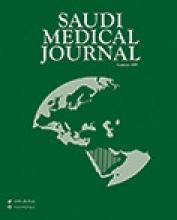Abstract
OBJECTIVE: To determine the risk factors for iron deficiency anemia among Saudi women of childbearing age.
METHODS: This is a case control study conducted at the primary health care clinics of King Khalid University Hospital in Riyadh over a 6-month period. Inclusion criteria included women of childbearing age and hemoglobin level < 120 g/l. Iron deficiency anemia was defined as having iron deficiency and low hemoglobin level < 120 g/l. Controls had hemoglobin level > 120 g/l and were matched with the cases for socio-demographic characteristics.
RESULTS: Eighty-seven patients and 203 controls were enrolled in the study. Low frequency of eating meat, vegetables or drinking juices right with vitamin C increased the risk of having iron deficiency anemia by 2-4 fold (odds ratio = 2.06, 95% confidence interval 1.20-3.54), (odds ratio = 2.86, 95% confidence interval 1.65-4.98) and (odds ratio = 3.75, confidence interval 2.20 - 6.42). Menstrual period duration of > 8 days, history of clots or flooding increased the odds of having iron deficiency anemia by 3-6 fold. The odds of being iron deficient in patients on non-steroidal anti-inflammatory drugs and antacid were 6-9 fold.
CONCLUSION: Important risk factors for iron deficiency anemia among Saudi women of childbearing age are dietary habits, menorrhagia and history of ingestion of non-steroidal anti-inflammatory drugs or antacids.
- Copyright: © Saudi Medical Journal
This is an open-access article distributed under the terms of the Creative Commons Attribution-Noncommercial-Share Alike 3.0 Unported, which permits unrestricted use, distribution, and reproduction in any medium, provided the original work is properly cited.






